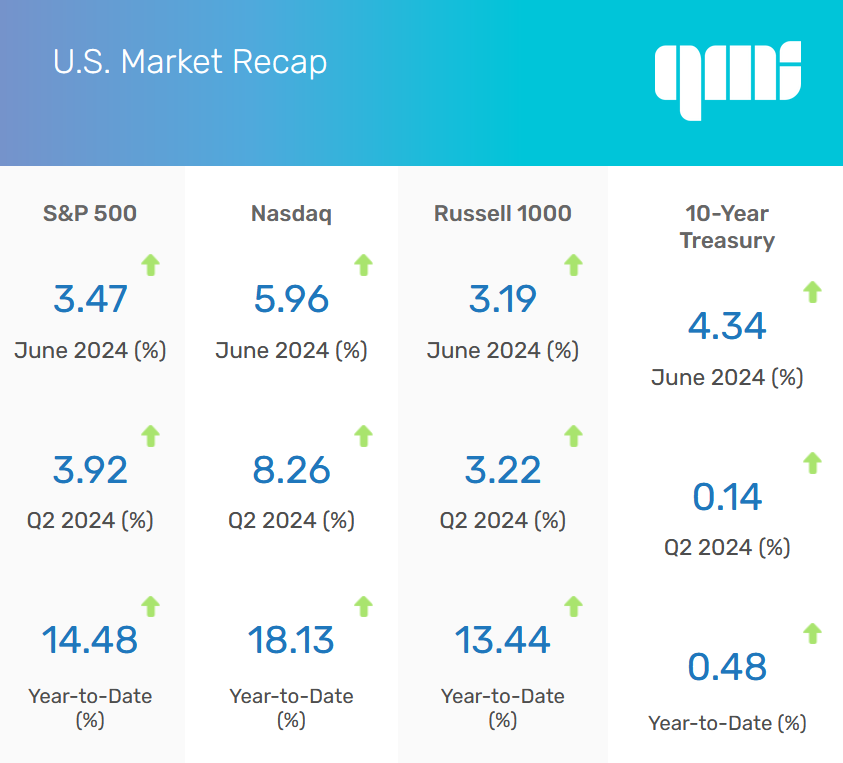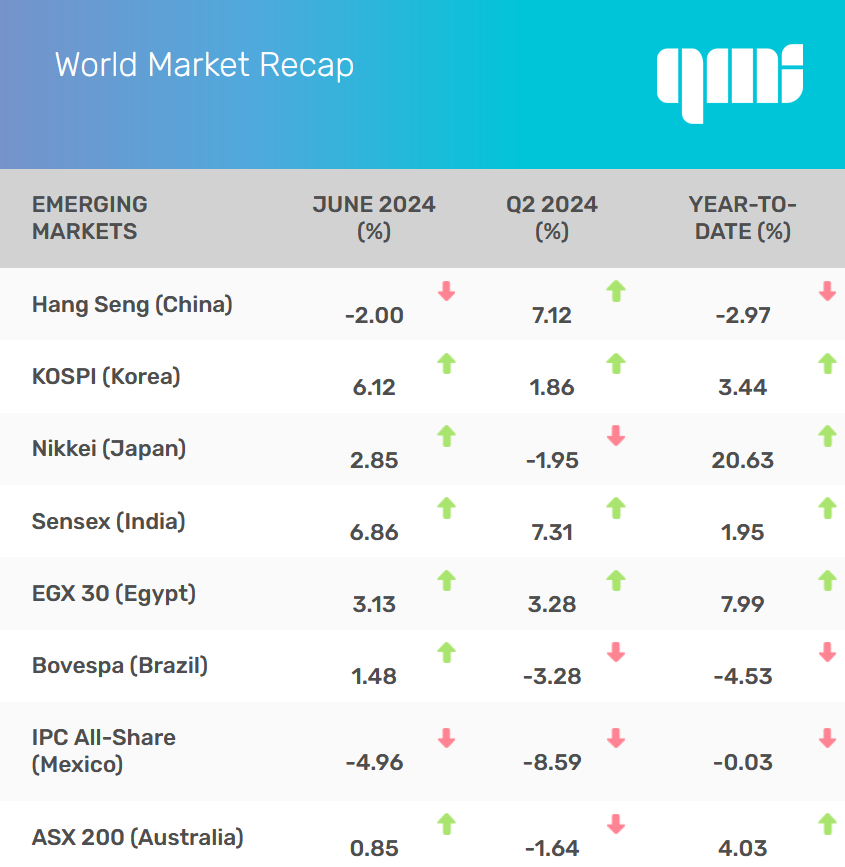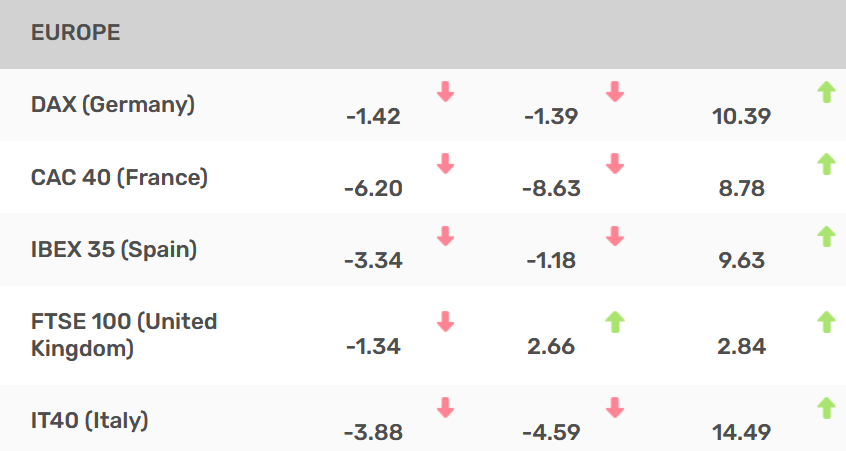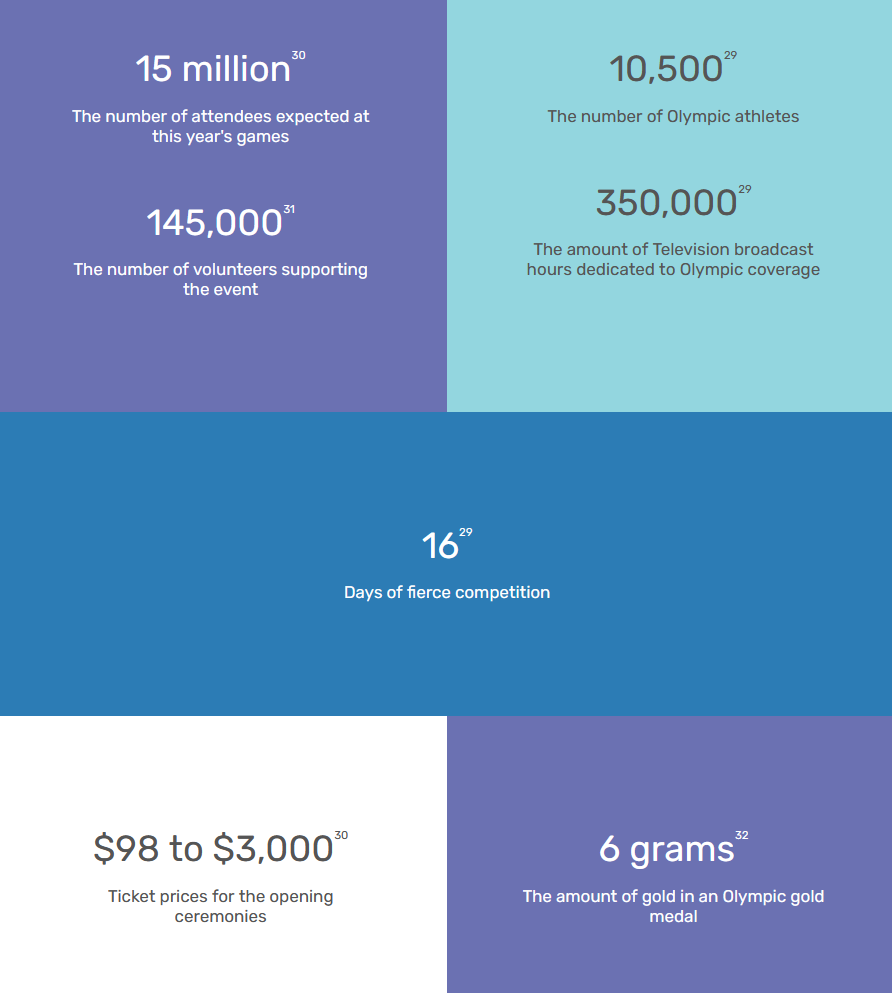 Ivana Lotoshynski, CFP®
Ivana Lotoshynski, CFP®
People Wealth Matters
Financial Advisor
https://peoplewealthmatters.com
ilotoshynski@peoplewealthmatters.com
Quarterly Market Insights | Q2 2024
U.S. Markets
Following a rocky start, stocks finished the second quarter higher as investors remained optimistic the Fed will manage interest rates with inflation trending lower.
For the quarter, the Standard & Poor’s 500 Index rose 3.92 percent, and the Nasdaq Composite picked up 8.26 percent. By contrast, the Dow Jones Industrial Average fell 1.73 percent.1
“You can’t put a limit on anything. The more you dream, the farther you get.”
Michael Phelps, USA Swimming, 28-time Olympic medalist including 23 Olympic gold medals
Rocky Start in Q2
Stocks lost ground in April as investors struggled with mixed economic news and mixed signals from the Fed.
Fresh Consumer Price Index data showed that March inflation was hotter than expected, However, retail sales for March suggested consumers were spending despite rising inflation. Fed Chair Jerome Powell possibly unsettled investors when his tone appeared to shift from confident to cagey about interest rate cuts. Also, tensions in the Middle East continued to rattle the markets.2,3,4
Goldilocks Economy
Markets turned in May, however, rallying around upbeat Q1 corporate reports and signs that the economy remained strong.
Some market watchers called it a “Goldilocks” economy, which is defined by economic activity that is neither too hot nor too cold. For example, the 175,000 jobs created in April was less than the 240,000 economists expected but still considered a solid showing.5,6
The Fed Remains in Focus
This momentum, along with news that inflation rose less than expected in May, bolstered investor sentiment. Enthusiasm was tempered, however, following the Fed’s policy meeting in which only one rate cut for the year was penciled in, versus the three previously communicated in March.7,8
Sector Scorecard
The second quarter also saw a dispersion of returns across sectors, compared with the first quarter, when nearly all sectors were in the green and in a tighter range.
Technology (+8.63 percent) and Communications Services (+4.91 percent) led the gains, both exceeding the S&P 500’s overall return. Utilities (+3.79 percent) and Consumer Staples (+0.29 percent) were the only other sectors in the green. Consumer Discretionary (-0.81 percent) was essentially flat. Of the six other sectors that declined, Materials fell the farthest (-4.93 percent), while Energy (-3.44 percent), Industrials (-3.25 percent), Real Estate (-2.83 percent), Financials (-2.40 percent), and Health Care (-1.34 percent) were also lower.9

Yahoo Finance, June 30, 2024. The market indexes discussed are unmanaged and generally considered representative of their respective markets. Individuals cannot directly invest in unmanaged indexes. Past performance does not guarantee future results. U.S. Treasury Notes are guaranteed by the federal government as to the timely payment of principal and interest. However, if you sell a Treasury Note prior to maturity, it may be worth more or less than the original price paid.
What Investors May Be Talking About in July
Early in the month, Companies will begin to give updates on business conditions in Q2 with some sharing their outlooks for Q3 and beyond. As these companies enter what is referred to as “earnings season,” FactSet research is estimating an (year-over-year) earnings growth rate for the S&P 500 at 8.8%. That would be the highest year-over-year growth rate since Q1 2022 (9.4 percent).10
Remember, forecasts or forward-looking statements are based on assumptions, subject to revision without notice, and may not materialize.
Along with business conditions, investors will be looking for updates on companies’ efforts with artificial intelligence. Of the S&P 500 companies, 199 cited the term “AI” during their earnings calls in Q1 2024. Will that number increase or decrease in Q2? By comparison, 219 companies mentioned the phrase “inflation” when discussing business conditions with shareholders in Q1, which was down from 303 a year earlier.11,12
The Fed meets once more before the fall season, July 30–31. At the conclusion of the June meeting, Fed Chair Powell said, “Inflation has eased over the past year but remains elevated.”
Fed officials adjusted their outlook and said they anticipate cutting short-term interest rates just once this year. Just a few months earlier, the Fed seemed prepared to cut rates three times in 2024. Investors are expected to react if the Fed adjusts its outlook for short-term rates again in July.13
World Markets
Much like the Dow Industrials, the MSCI EAFE Index fell 1.48 percent during the second quarter. Political uncertainty in Europe and investor concerns over Japan’s monetary policy contributed to the decline.14
Among European markets, France dropped 8.63 percent, Italy fell 4.59 percent, and Germany slipped 1.39 percent. By contrast, the UK rose 2.66 percent for the three-month period.15
Elsewhere, India picked up 7.31 percent while China’s Hang Seng index rose 7.12 percent. But Mexico lost 8.59 percent, Brazil fell 3.28 percent, and Australia dipped 1.64 percent.16


Yahoo Finance, June 30, 2024. The market indexes discussed are unmanaged and generally considered representative of their respective markets. Individuals cannot directly invest in unmanaged indexes. Past performance does not guarantee future results. International investments carry additional risks, which include differences in financial reporting standards, currency exchange rates, political risks unique to a specific country, foreign taxes and regulations, and the potential for illiquid markets. These factors may result in greater share price volatility.
Indicators
Gross Domestic Product (GDP)
The U.S. economy grew at a revised 1.4 percent in Q1—upward from the last estimate of 1.3 percent, but downward from the initial estimate of 1.6 percent. It was below economists’ expectations of 2.4 percent and below the fourth quarter’s 3.4 percent rate.17
Employment
Employers added 272,000 jobs in May, higher than the 190,000 economists expected. Unemployment edged up to 4.0 percent in May (versus April’s 3.9 percent rise), the first time in over two years the jobless rate hit 4 percent. Average hourly earnings increased 4.1 percent year over year in May, an uptick from April’s 3.9 percent wage growth.18
Retail Sales
Retail spending inched up 0.1 percent in May, below economists’ expectations. Sales increased 2.3 percent year over year.19
Industrial Production
Industrial output rose 0.9 percent in May as manufacturing staged a rebound and utilities boosted production. The increase bested economist expectations of 0.4 percent.20
Housing
New home construction dropped 5.5 percent in May to the lowest level in four years, spurred by higher financing costs for homebuilders and higher mortgage rates for homebuyers.21
Sales of existing homes fell 0.7 percent in May from the prior month. The median home sales price jumped to a record high $419,300.22
New home sales fell 11.3 percent in May, a decline from April’s upwardly revised 2.0 percent month-over-month gain—as higher mortgage rates appeared to continue taking a toll on demand. Year-over-year sales fell 16.5 percent.23
Consumer Price Index (CPI)
Consumer prices were essentially flat in May compared with the prior month, and up 3.3 percent from a year ago. Core CPI, which excludes food and energy, increased 0.2 percent in May—below expectations. Shelter, which rose 0.4 percent, was the largest factor for May’s increase in core prices.24
Durable Goods Orders
Orders of manufactured goods designed to last three years or longer increased 0.1 percent in May—the fourth consecutive month of gains. Orders of transportation equipment led the overall increase.25
The Fed
The Fed left interest rates unchanged at both Federal Open Market Committee (FOMC) meetings held in the second quarter.26
Minutes from the April/May meeting stated that some Fed officials worried about the lack of progress on inflation.
After the June 11-12 meeting, some investors were unsettled after learning Fed officials had shifted their outlook based on continued stubborn inflation data, and now only penciled in a single rate cut for the rest of the year. Back in March, the majority of Fed officials had indicated as many as three cuts were possible this year.
The next FOMC meeting will be July 30-31.
By the Numbers: 2024 Paris Summer Olympics


The content is developed from sources believed to be providing accurate information. The information in this material is not intended as tax or legal advice. Please consult legal or tax professionals for specific information regarding your individual situation. This material was developed and produced by FMG Suite to provide information on a topic that may be of interest. FMG Suite, LLC, is not affiliated with the named representative, broker-dealer, or state- or SEC-registered investment advisory firm. The opinions expressed and material provided are for general information and should not be considered a solicitation for the purchase or sale of any security.
Investing involves risks, and investment decisions should be based on your own goals, time horizon and tolerance for risk. The return and principal value of investments will fluctuate as market conditions change. When sold, investments may be worth more or less than their original cost.
Any companies mentioned are for illustrative purposes only. It should not be considered a solicitation for the purchase or sale of the securities. Any investment should be consistent with your objectives, timeframe, and risk tolerance.
The forecasts or forward-looking statements are based on assumptions, subject to revision without notice, and may not materialize.
The market indexes discussed are unmanaged and generally considered representative of their respective markets. Individuals cannot directly invest in unmanaged indexes. Past performance does not guarantee future results.
The Dow Jones Industrial Average is an unmanaged index that is generally considered representative of large-capitalization companies on the U.S. stock market. The S&P 500 Composite Index is an unmanaged group of securities considered to be representative of the stock market in general. The Nasdaq Composite is an index of the common stocks and similar securities listed on the Nasdaq stock market and considered a broad indicator of the performance of stocks of technology and growth companies. The Russell 1000 Index is an index that measures the performance of the highest-ranking 1,000 stocks in the Russell 3000 Index, which is comprised of 3,000 of the largest U.S. stocks. The MSCI EAFE Index was created by Morgan Stanley Capital International (MSCI) and serves as a benchmark for the performance in major international equity markets, as represented by 21 major MSCI indexes from Europe, Australia, and Southeast Asia. Index performance is not indicative of the past performance of a particular investment. Past performance does not guarantee future results. Individuals cannot invest directly in an index. The return and principal value of stock prices will fluctuate as market conditions change. And shares, when sold, may be worth more or less than their original cost.
International investments carry additional risks, which include differences in financial reporting standards, currency exchange rates, political risks unique to a specific country, foreign taxes and regulations, and the potential for illiquid markets. These factors may result in greater share price volatility.
The Hang Seng Index is a benchmark index for the blue-chip stocks traded on the Hong Kong Stock Exchange. The KOSPI is an index of all stocks traded on the Korean Stock Exchange. The Nikkei 225 is a stock market index for the Tokyo Stock Exchange. The SENSEX is a stock market index of 30 companies listed on the Bombay Stock Exchange. The Jakarta Composite Index is an index of all stocks that are traded on the Indonesia Stock Exchange. The Bovespa Index tracks 50 stocks traded on the Sao Paulo Stock, Mercantile, & Futures Exchange. The IPC Index measures the companies listed on the Mexican Stock Exchange. The MERVAL tracks the performance of large companies based in Argentina. The ASX 200 Index is an index of stocks listed on the Australian Securities Exchange. The DAX is a market index consisting of the 30 German companies trading on the Frankfurt Stock Exchange. The CAC 40 is a benchmark for the 40 most significant companies on the French Stock Market Exchange. The Dow Jones Russia Index measures the performance of leading Russian Global Depositary Receipts (GDRs) that trade on the London Stock Exchange. The FTSE 100 Index is an index of the 100 companies with the highest market capitalization listed on the London Stock Exchange.
Please consult your financial professional for additional information.
Copyright 2024 FMG Suite.
1. WSJ, June 28, 2024
2. WSJ.com, April 4, 2024
3. WSJ.com, April 16, 2024
4. CNBC.com, April 15, 2024
5. CNBC.com, May 15, 2024
6. CNBC.com, May 3, 2024
7. WSJ.com, June 12, 2024
8. APNews.com, June 27, 2024
9. Sectorspdrs.com, June 30, 2024
10. Insight.FactSet.com, June 21, 2024
11. Insight.FactSet.com, May 24, 2024
12. Insight.FactSet.com, May 17, 2024
13. CNBC.com, June 12, 2024
14. MSCI, June 30, 2024
15. MSCI, June 30, 2024
16. MSCI, June 30, 2024
17. BureauofEconomicAnalysis.gov, June 27, 2024
18. WSJ.com, June 7, 2024
19. CNBC.com, June 18, 2024
20. IndustryWeek.com, June 18, 2024
21. Marketwatch.com, June 20, 2024
22. National Association of Realtors, June 21, 2024
23. Reuters, June 26, 2024
24. WSJ.com, June 12, 2024
25. BankingJournal.aba.com, June 27, 2024
26. WSJ.com, June 12. 2024
27. Wikipedia.com, July 2, 2024
28. ESPN.com, May 14, 2024
29. Olympics.com, July 2, 2024
30. Forbes.com, April 24, 2024
31. EuroNews.com, January 31, 2024
32. NBC.com, June 23, 2024




